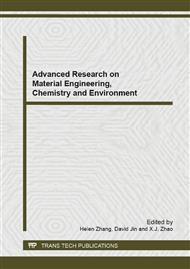p.456
p.460
p.466
p.471
p.476
p.480
p.486
p.493
p.498
Study on the Antibiotic Bacterial Residue for the Human Health Risk Assessment
Abstract:
As antibiotic bacteria residue contains many toxic substances such as antibiotic residues, heavy metals and polycyclic aromatic hydrocarbons, it was listed as hazardous waste by government. This paper used Analytic Hierarchy Process to set up the evaluating index system and made a quantitative evaluation of those risk factors in the disposal process. It could be concluded that antibiotic bacteria residue and its metabolites were the major environmental risk factors. Furthermore, this paper took the waste of tetracycline for an example, and divided the disposal technologies into two categories (disposal rate of 0% and over 90%) and then made the human health risk assessment according to the procedure of EPA.. As a result, the risk values were lower than the acceptable lever, which showing that the risk of the tetracycline bacterial residue was very small for humanity.
Info:
Periodical:
Pages:
476-479
Citation:
Online since:
September 2013
Authors:
Keywords:
Price:
Сopyright:
© 2013 Trans Tech Publications Ltd. All Rights Reserved
Share:
Citation:


